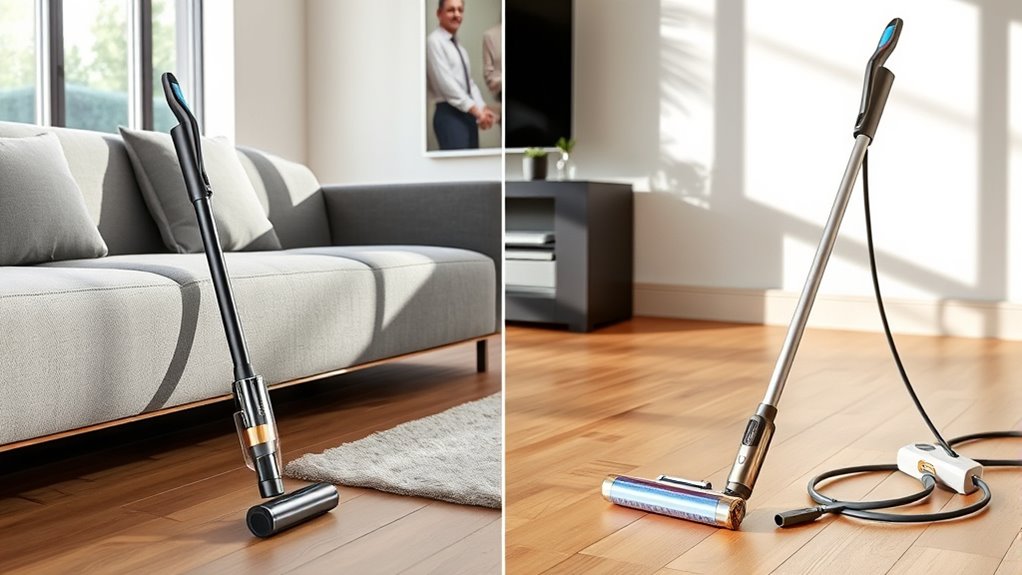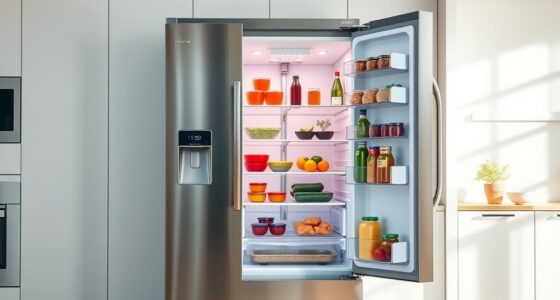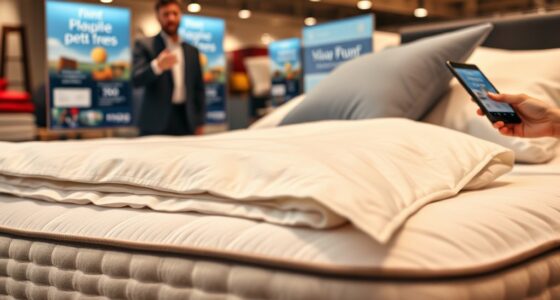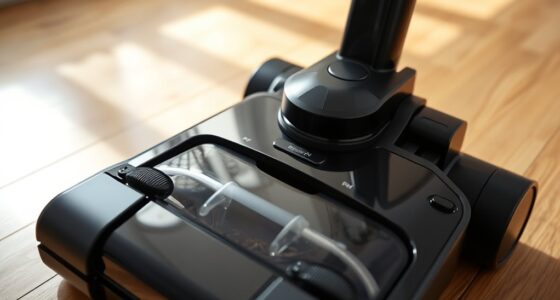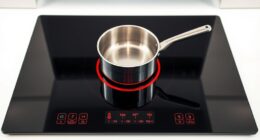If you want powerful cleaning and long-lasting performance, a corded vacuum is your best bet, especially for larger homes with carpets. For quick, easy clean-ups and flexibility, a cordless stick vacuum offers great convenience, especially in smaller spaces or on hard floors. Consider your home size, flooring type, and cleaning frequency to choose the best fit. Want to explore which model best suits your home? Keep going for more insights.
Key Takeaways
- Corded vacuums offer consistent, high power ideal for deep cleaning and larger areas, lasting longer without battery concerns.
- Cordless vacuums provide unmatched maneuverability and convenience for quick, everyday cleanups and hard-to-reach spots.
- Consider home size and flooring type: small apartments suit cordless models, while larger homes with carpets benefit from corded power.
- Cordless models may require battery replacements after 3–5 years, adding long-term costs, whereas corded vacuums typically last 8–10 years.
- For versatile, multi-surface cleaning and ease of use, cordless stick vacuums are often preferable; for heavy-duty, prolonged tasks, corded is more suitable.
Comparing Suction and Cleaning Power
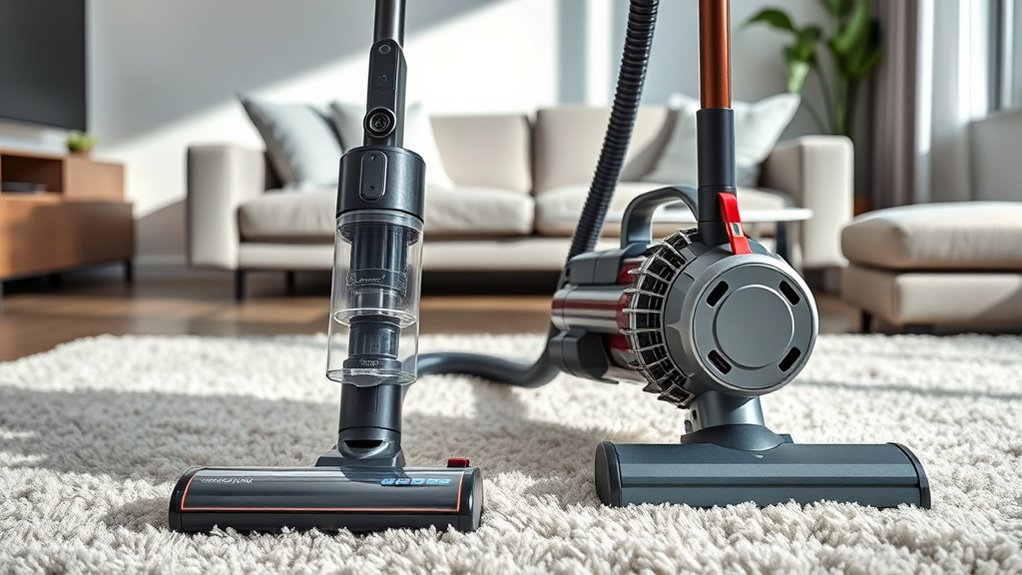
When comparing suction and cleaning power, corded vacuums generally lead the way because their powerful motors are directly connected to mains electricity, providing consistent and higher suction levels. This means your cleaning performance remains steady, especially on carpets and stubborn debris. Cordless vacuums, like Dyson Gen5detect, now deliver impressive suction that can rival some corded models, particularly on hard floors. Suction power, often measured in air watts or pascals, indicates how well a vacuum cleans. High-end cordless models with advanced batteries can maintain strong suction throughout their runtime, approaching corded vacuum performance. Additionally, battery technology improvements have enabled cordless vacuums to sustain high suction levels longer, making them more versatile. The airflow system in corded vacuums is designed to optimize suction and dirt removal efficiency, further boosting their cleaning prowess. Motor power plays a crucial role in overall suction capability and is generally more consistent in corded models, which contributes significantly to their deep-cleaning effectiveness. In fact, the design of the vacuum body can influence how effectively suction is delivered and maintained. Moreover, filtration systems, particularly HEPA filters, in corded vacuums often enhance overall cleaning by trapping more dust and allergens, further emphasizing their cleaning strength. However, for deep cleaning tasks or heavy-duty use, corded vacuums tend to offer the edge due to their continuous, higher suction capacity.
Evaluating Battery Life and Operating Time
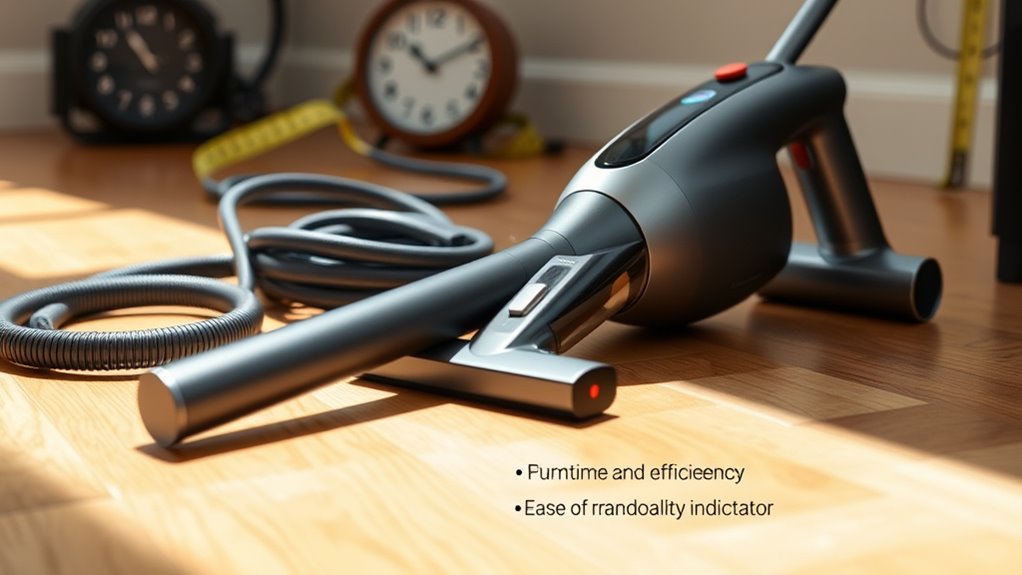
Cordless stick vacuums vary widely in battery life, typically offering between 15 and 60 minutes of runtime per full charge depending on the model and power setting. Your operating time decreases when using higher power modes or turbo settings, which drain the battery faster. High-end models like Dyson Gen5detect can provide up to 70 minutes on Eco Mode but often weigh more due to larger batteries. Charging times differ, ranging from 2 to 16 hours, though some models feature quick-charging to reduce downtime. Keeping track of battery health is important to maintain optimal performance over time. Regular monitoring of market trends can also help you anticipate when to upgrade or replace your vacuum’s battery for better efficiency. Keep in mind that the battery life of cordless vacuums limits their operating time, so for extended cleaning sessions, you might need to recharge or swap batteries. Understanding these factors helps you choose a model that matches your cleaning needs. Additionally, Mazda Tuning techniques can optimize the overall efficiency and performance of your vehicle, similar to how selecting the right vacuum depends on understanding its capabilities. Proper battery management and choosing models with longer operating times can ensure your cleaning tasks are completed without interruption.
To maximize efficiency, consider models with smart power management features that optimize battery usage based on the task at hand.
Considering Ease of Use and Mobility
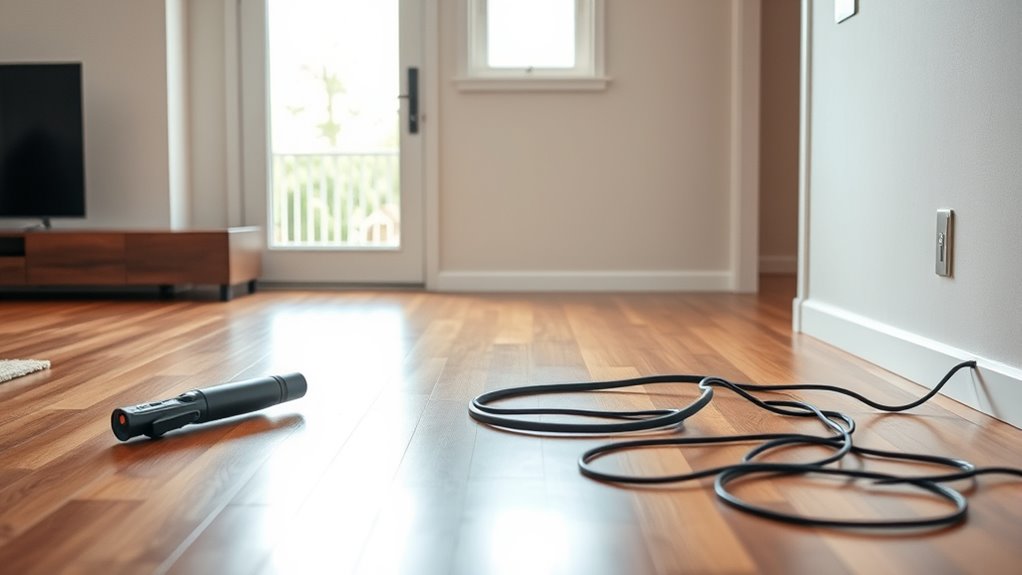
Thanks to their lightweight design and lack of cords, cordless stick vacuums offer exceptional ease of use and mobility. Weighing between 5 to 7 pounds, they’re easy to carry and maneuver around your home. Without cords, you’ll enjoy unrestricted movement, making it simple to clean stairs, furniture, and hard-to-reach spots without hassle. The ergonomic design, adjustable handles, and intuitive controls further enhance user comfort, allowing you to operate the vacuum efficiently. Plus, since there are no cords to tangle or trip over, your cleaning sessions become safer and more convenient. The quick runtime of 15 to 60 minutes fits short cleaning tasks, so you won’t need to find a power outlet constantly. Additionally, the high refresh rates of some models ensure smooth operation during extended cleaning sessions. The portability of cordless vacuums makes them especially suitable for quick clean-ups and multi-room cleaning. When choosing a model, consider the battery life to ensure it meets your cleaning needs for larger areas. Modern cordless models often feature advanced motor technology, which enhances cleaning efficiency and reduces noise during operation.
Assessing Versatility and Multi-Functionality
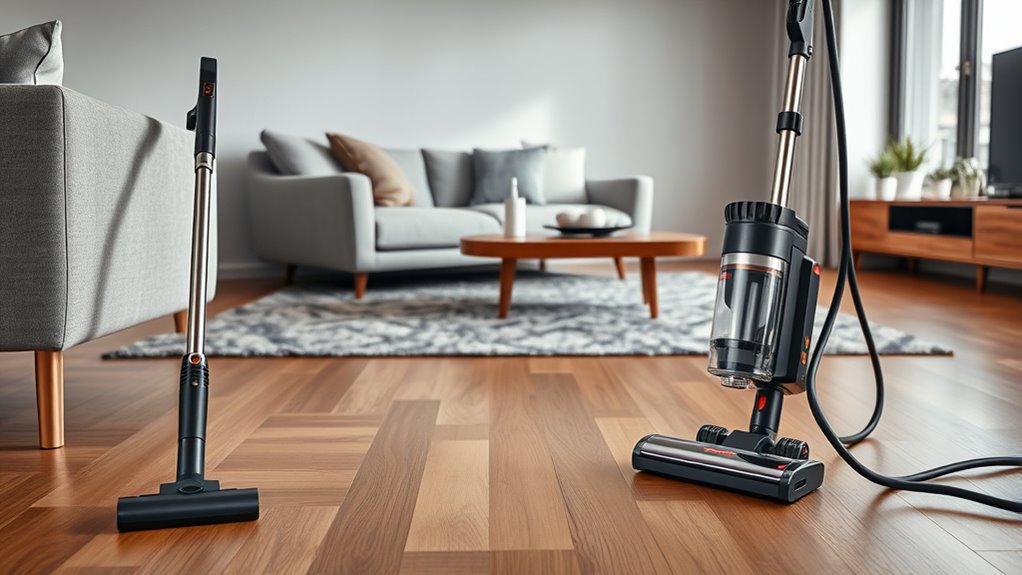
Because they can easily transform into handheld devices, cordless stick vacuums offer impressive versatility for various cleaning tasks around your home, car, or furniture. With a range of attachments like crevice tools and upholstery brushes, you can effortlessly adapt to different surfaces and messes. This multi-functionality means you’re always ready for quick cleanups or detailed cleaning sessions. Switching between floor modes or attaching accessories allows you to clean multiple surfaces efficiently. Additionally, their lightweight design makes extended cleaning sessions more manageable and less tiring. The ability to shift gears smoothly when navigating different areas ensures that the vacuum maintains optimal performance across various surfaces.
Analyzing Cost and Long-Term Expenses
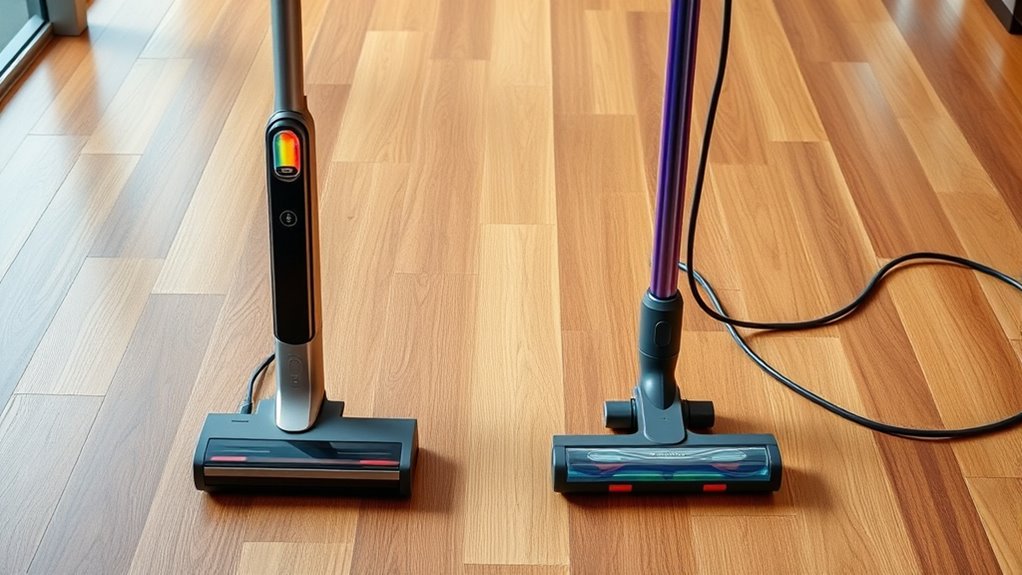
When comparing the costs of cordless and corded stick vacuums, it’s important to contemplate both upfront prices and ongoing expenses. Cordless models typically range from $100 to $600, while corded vacuums can cost between $50 and over $1,500. The long-term expense of cordless vacuums often involves battery replacements, which can cost $50 to $150, and shorter lifespans of 3 to 5 years due to battery degradation. In contrast, corded vacuums generally don’t require battery maintenance and can last 8 to 10 years with proper care. Investing in a higher-quality corded vacuum may be more cost-effective over time because of their durability. Additionally, understanding the long-term energy savings aspects, such as efficiency ratings and proper usage, can help you make a more informed decision. Proper maintenance and mindful usage can significantly extend the lifespan of your vacuum and optimize its performance efficiency. Moreover, considering cost-effectiveness when choosing a vacuum can lead to better financial decisions over its lifespan. Conducting a cost-benefit analysis that factors in initial costs, maintenance, and energy use can further clarify the best choice for your household. Consider these factors to determine which type aligns best with your long-term budget and cleaning needs. Additionally, understanding the behavioral support aspects, such as managing user expectations and proper maintenance, can help extend the lifespan of your vacuum.
Examining Durability and Environmental Impact
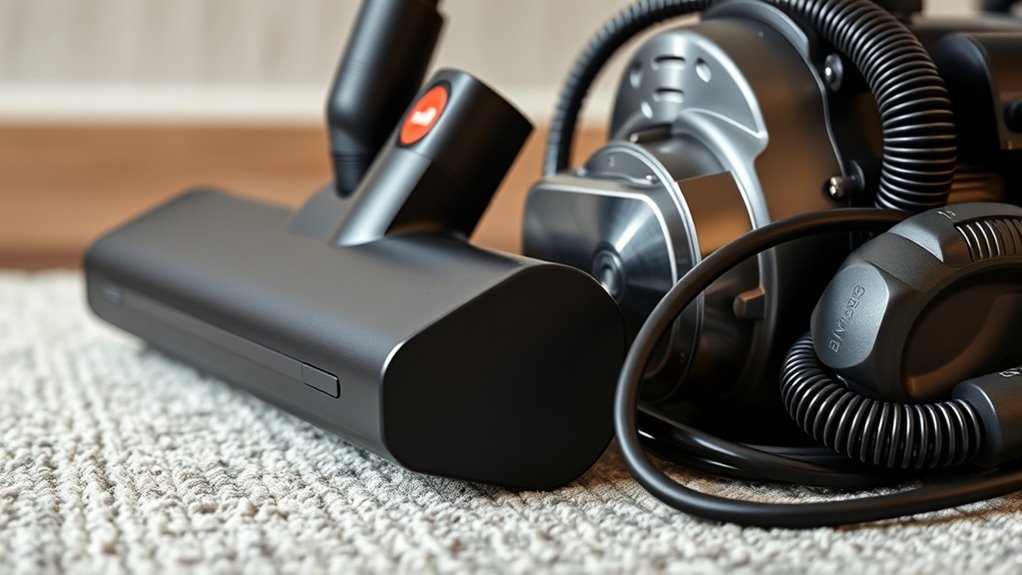
Corded vacuums generally last longer—about 8 to 10 years—since they have fewer electronic parts and don’t rely on batteries that degrade over time. This increased durability makes them a more sustainable choice, especially if you’re concerned about environmental impact. In contrast, cordless vacuums often need battery replacements after 3-5 years, which can affect their lifespan and generate battery disposal concerns. Improper disposal of lithium-ion batteries poses environmental risks, highlighting the importance of recycling. Many modern corded models incorporate eco-friendly features like recyclable materials and compostable dust bags, reducing their environmental footprint. Additionally, the maintenance of corded vacuums can be simpler due to fewer components that require regular replacement, leading to fewer waste products over time. Overall, if durability and minimizing environmental impact are priorities, corded vacuums typically offer a more sustainable and long-lasting solution.
Matching Vacuum Type to Home Size and Flooring

Choosing the right vacuum depends on your home size and flooring types. For small apartments with hard floors, lightweight cordless models make quick work of cleaning. Larger homes with carpets may require corded vacuums with more power and capacity to handle frequent, deep cleanings.
Home Size Considerations
If your home is under 600 square feet with minimal rugs, a lightweight cordless stick vacuum is ideal for quick, hassle-free cleaning. Small spaces benefit from cordless vacuums’ portability and ease of use, making daily tidying simple. Larger homes with extensive carpeting and multiple rooms usually require corded vacuums, which offer higher suction power and larger dustbins for thorough cleaning. Homes with mixed flooring benefit from versatile cordless models with adjustable settings. For multi-level homes or stairs, cordless vacuums provide better maneuverability without extension cords. Consider this table to match your home size with the right vacuum:
| Home Size | Recommended Vacuum Type |
|---|---|
| Under 600 sq. ft. | Cordless vacuums |
| Larger with carpets | Corded vacuums |
| Multi-level or mixed floors | Versatile cordless vacuums |
Flooring Type Impact
The type of flooring in your home plays a significant role in determining the most suitable vacuum. For hard floors like hardwood or tile, cordless vacuums are ideal because they’re lightweight and easy to maneuver, making quick cleanups simple without cord restrictions. If you have carpeted floors, especially thick or high-pile carpets, a corded vacuum with powerful suction is better, providing consistent deep cleaning. Small apartments with minimal rugs benefit from cordless models for convenience. Homes with mixed flooring types can use versatile cordless vacuums with adjustable settings to switch effortlessly between hard floors and carpets. For extensive carpeting or high-traffic areas, a corded vacuum’s larger dust capacity and continuous power guarantee thorough cleaning across various flooring types.
Cleaning Frequency Needs
How often you need to clean depends largely on your home’s size, flooring type, and lifestyle. For small apartments under 600 sq. ft. with minimal rugs, cordless vacuums are perfect for quick, frequent cleanings thanks to their portability and fast charging. Larger homes with extensive carpeting and high traffic areas benefit from corded vacuums, which can handle more frequent, deep cleanings with continuous power and larger dust capacity. If you have pets or kids, quick cleanups of spills or pet hair become easier with cordless vacuums offering longer runtime. For weekly or bi-weekly routines, a combination of both types works best—cordless for spot cleaning and quick tasks, corded for thorough, regular deep cleans. Match your cleaning needs to your home’s size and flooring to keep your space spotless.
Understanding Maintenance and Upkeep Needs
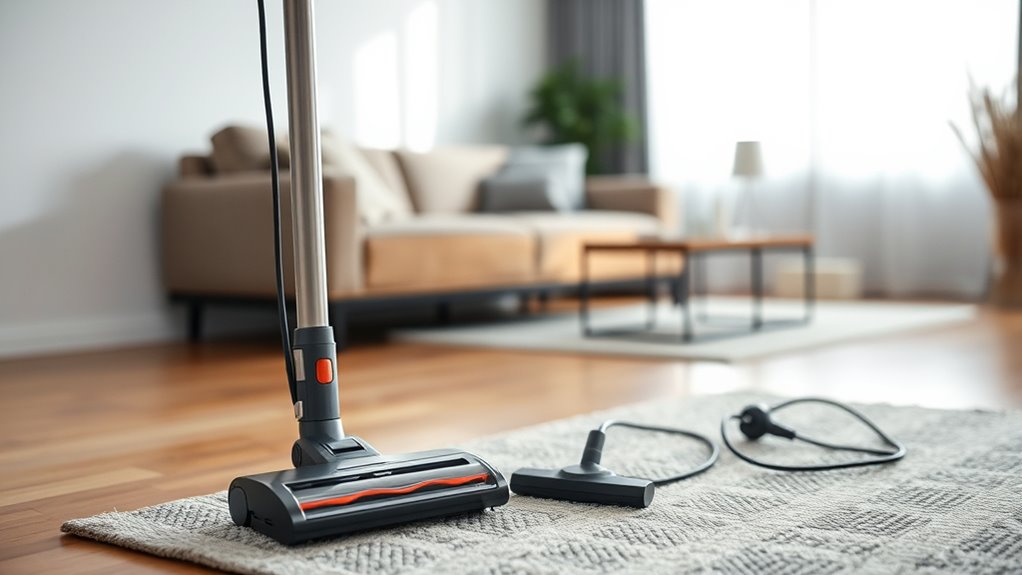
Maintaining your vacuum properly guarantees it continues to perform at its best and lasts longer. For cordless vacuums, this means regular filter cleaning, dustbin emptying, and occasional battery maintenance or replacement to keep power and suction strong. Visualize yourself:
- Rinsing filters to prevent clogs and ensure good airflow
- Emptying the dustbin before it overflows, avoiding suction loss
- Checking the battery health, replacing it when performance declines
- Inspecting brushes and attachments for debris buildup
Corded models require less attention to power source upkeep but still benefit from periodic filter cleaning and dustbin emptying. Regular maintenance helps both types maintain peak efficiency, prolongs lifespan, and keeps your home cleaning smooth and effective.
Weighing Convenience for Different Cleaning Tasks

When choosing between cordless and corded vacuums, consider how easy they are to maneuver, reach, and handle for different tasks. Cordless models are great for quick clean-ups and tight spaces, offering convenience and portability. For larger areas or deep cleaning, corded vacuums provide continuous power and better reach, making your chores more efficient.
Ease of Maneuvering
Cordless stick vacuums offer superior maneuverability, making them particularly convenient for a variety of cleaning tasks. Their lightweight design and portability allow you to easily navigate around furniture, tight corners, and stairs. Without a cord to restrict your movement, you can seamlessly switch rooms or move outdoors without interruption. Imagine yourself:
- Gliding effortlessly across different floor types
- Easily reaching under furniture and into tight spaces
- Carrying the vacuum upstairs without strain
- Quickly switching from floor to upholstery with attachments
These features reduce user fatigue and improve ease of movement during extended cleanings. The compact size and ergonomic handles make maneuvering more comfortable, giving you better control and less effort. Overall, cordless vacuums provide unmatched flexibility for your cleaning needs.
Reach and Accessibility
Because they eliminate the hassle of managing cords, cordless stick vacuums make it easy to reach high shelves, stairs, and tight corners, enhancing your ability to clean various surfaces effortlessly. Their portability improves accessibility, allowing you to clean above-floor areas like upholstery and car interiors without needing an outlet nearby. With no cord restrictions, you can smoothly move from room to room and access hard-to-reach spots without interruption. This flexibility is especially useful for cleaning under furniture or in outdoor spaces where outlets might not be available. In contrast, corded vacuums are limited by their cord length, which can restrict reach and require repositioning. Overall, cordless vacuums provide superior accessibility, making your cleaning routine more efficient and less cumbersome.
Quick Clean-Up Capability
The lightweight design and cordless operation of stick vacuums make them ideal for quick clean-ups around your home. With their ease of use, you can swiftly tackle small spills, dust, and debris without hassle. Imagine grabbing your vacuum, effortlessly gliding from room to room. The benefits include:
- Light maneuverability around furniture and tight spaces
- No need to search for outlets, saving time
- Quick conversion into handheld mode for targeted cleaning
- 15 to 60 minutes of runtime for fast, focused tasks
This combination of portability and power allows you to handle urgent messes efficiently. Whether it’s crumbs on the sofa or dirt in the car, your cordless stick vacuum’s quick clean-up capability makes it a practical choice for everyday convenience.
Frequently Asked Questions
Is It Better to Get a Corded or Cordless Stick Vacuum?
You wonder whether a corded or cordless stick vacuum suits you better. If you need powerful, consistent cleaning for large areas or deep messes, a corded model is ideal because it offers steady suction and larger capacity. But if you value convenience, quick cleanups, and maneuverability, a cordless vacuum works well, especially if your home is smaller or you prefer lightweight tools. Consider your cleaning needs and lifestyle to choose the best fit.
What Are the Disadvantages of a Cordless Vacuum Cleaner?
You should know that cordless vacuum cleaners have some disadvantages. Their battery life is limited, typically lasting 15 to 60 minutes, which can interrupt your cleaning. You’ll need to recharge frequently and possibly replace batteries over time. The dust canisters are small, requiring frequent emptying, and they usually have less suction power than corded vacuums. Over time, battery performance declines, reducing the vacuum’s effectiveness and lifespan.
Can a Cordless Vacuum Replace a Corded Vacuum?
You’re asking if a cordless vacuum can truly replace a corded one. While cordless models pack a punch for quick cleanups, they might not cut it for heavy-duty or large-area tasks due to limited battery life. If you want consistent, long-lasting power, a corded vacuum is still the best bet. Don’t put all your eggs in one basket—consider your cleaning needs before making the switch.
Is There a Vacuum That Is Both Corded and Cordless?
Yes, there are vacuums that are both corded and cordless. These hybrid models let you switch between plugged-in power and cordless portability, giving you flexibility for different cleaning tasks. You can use the corded mode for deep cleaning or larger areas, then switch to cordless for quick, easy pickups. With modular components, you can detach or attach parts as needed, making these vacuums a versatile choice for your home.
Should I Get a Cordless or Upright Vacuum?
You’re trying to decide if a cordless or upright vacuum suits your needs. If you want lightweight, easy maneuverability for quick cleanups and smaller spaces, a cordless model’s perfect. However, if you need powerful suction and larger capacity for deep cleaning big areas, an upright vacuum’s the better choice. Consider your home size, cleaning routine, and budget to pick the option that makes your cleaning easier and more efficient.
Conclusion
Now, imagine walking your home, effortlessly gliding with the perfect vacuum—cordless freedom or corded power. Will you choose the convenience that moves with you or the relentless strength that never quits? The decision awaits, and your ideal cleaning companion is out there, ready to transform your space. The question is: which one will you bring home, and what surprises will your choice uncover in the days ahead? The cleanest, easiest tomorrow is just a decision away.
